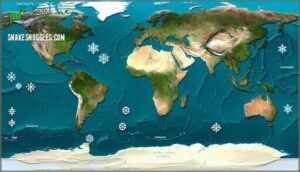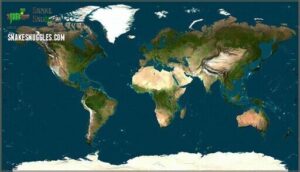This site is supported by our readers. We may earn a commission, at no cost to you, if you purchase through links.
 You won’t find a single snake slithering through the icy wilds of Antarctica or hiding in the mossy hedgerows of Ireland. Even New Zealand, with its lush forests and rolling green hills, stands apart as one of the world’s rare places where snakes don’t make an appearance.
You won’t find a single snake slithering through the icy wilds of Antarctica or hiding in the mossy hedgerows of Ireland. Even New Zealand, with its lush forests and rolling green hills, stands apart as one of the world’s rare places where snakes don’t make an appearance.
Whether it’s raging blizzards, oceanic barricades, or vigilant quarantine practiced by island nations, the reasons behind these snake-free pockets are as fascinating as their landscapes. If you’ve ever wondered about corners of the globe untouched by snakes, understanding where—and why—these places exist might just shift how you see nature’s balance.
Table Of Contents
- Key Takeaways
- Where Are There No Snakes in The World?
- Why Are Some Places Snake-Free?
- Snake-Free Regions: Detailed List
- Human Impact on Snake Absence
- Global Snake Distribution and Ecology
- Frequently Asked Questions (FAQs)
- Is there any place in the world without snakes?
- Why are there no snakes in Hawaii?
- Why does Ireland have no snakes?
- Where do snakes not live?
- Where in the world do not have snakes?
- Are there snakes in the world?
- Which countries have no snakes in 2024?
- Where do snakes not go?
- Are there snakes in North America?
- Where are snakes found?
- Conclusion
Key Takeaways
- Several places on Earth remain completely snake-free due to extreme cold climates, geographic isolation by oceans or mountains, or post-glacial history that prevented snakes from ever reaching these regions—including Antarctica, New Zealand, Ireland, Iceland, Greenland, and numerous Pacific islands.
- Cold-blooded snakes can’t survive in freezing environments like Antarctica because their metabolism shuts down without warmth, making regions with harsh winters and minimal sunlight naturally inhospitable to all snake species.
- Countries like New Zealand and Hawaii maintain their snake-free status through strict biosecurity laws, heavy penalties for smuggling, and active enforcement to protect native ecosystems from the ecological damage invasive snakes could cause.
- Human activity continues to shape snake distribution worldwide through habitat destruction, climate change, and the introduction of invasive species, while conservation efforts work to preserve both snake-free regions and the ecological balance snakes maintain elsewhere as rodent controllers and prey for other wildlife.
Where Are There No Snakes in The World?
If you’ve ever wondered where you can travel or live without worrying about snakes, you’re not alone. Some places around the world are known for being completely snake-free. Let’s take a look at these unique regions and what sets them apart.
Snake-Free Continents and Countries
Across the globe, snake-free regions stand out for their unique absence mechanisms. Antarctica’s extreme cold is a clear climate influence, making it impossible for snakes to survive.
Ireland and New Zealand are also places without snakes, thanks to glaciation and strict legal prohibitions. These countries maintain ecosystem stability through isolation, law, and the principles of island biogeography.
Hawaii’s ecosystem remains snake-free due to its geographical isolation.
Notable Snake-Free Islands
You’ll notice that some islands, like Iceland, Greenland, the Cook Islands, and Cape Verde, stand out for being truly snake-free. Thanks to geographic isolation and cold climates, these unique ecosystems remain untouched by snakes.
Pacific Islands such as Tuvalu and Kiribati also fit the bill, attracting ecotourism and supporting conservation strategies shaped by island biogeography and introduced species risks.
Some snake-free islands are maintained through conservation and efforts.
Regions With Strict Snake Regulations
For instance, places like Hawaii and New Zealand use strict laws and biosecurity measures to guard their snake-free regions. Enforcement challenges and regulation loopholes can make snake control tricky, but hefty penalties and public awareness campaigns help.
Conservation laws and snakes go hand in hand, with biosecurity measures and snake control remaining strong where nature alone isn’t enough.
Why Are Some Places Snake-Free?
You might wonder why some places never see a single snake. It often comes down to climate, geography, and history. Let’s look at the main reasons behind these snake-free zones.
Impact of Cold Climates on Snakes
Have you ever wondered why snakes steer clear of places where winter bites hard and the sun barely warms the ground? Cold climates challenge snake metabolism rates and limit their ability to move or hunt. Here’s how cold climates and snakes don’t mix:
- Reduced metabolism
- Limited hibernation strategies
- Geographic limitations
- Evolutionary pressures
- Snakefree regions like Antarctica and the Arctic
Geographic Isolation and Natural Barriers
Across oceans and mountain ranges, natural barriers act like invisible fences, keeping snakes from ever reaching certain corners of the world. Island snake absence is often due to oceanic barriers, which limit snake dispersal and create isolated ecosystems. Geographic isolation shapes evolutionary implications for these snake-free regions.
| Barrier Type | Example Location | Effect on Snakes |
|---|---|---|
| Ocean | New Zealand | Prevents arrival |
| Mountains | Iceland | Restricts movement |
| Distance | Cape Verde | Limits colonization |
| Climate | Antarctica | Blocks survival |
| Isolation | Cook Islands | Maintains absence |
Historical and Environmental Factors
After the last glaciers melted, some places remained off-limits for snakes because cold climates and rugged isolation locked them out. Fossil Absence in Ireland or Greenland tells you snakes never arrived, while rapid Speciation Dynamics elsewhere left these regions untouched. Layered together, history, climate constraints, and human influence shape where snakes call home—and where they never could.
Post-glacial isolation, extreme climates, and geographic barriers left some regions permanently snake-free, shaped by history rather than evolution
- Glacial Impacts left Ireland snake-free.
- Climate constraints keep Greenland inhospitable.
- Laws in New Zealand prevent accidental introductions.
Snake-Free Regions: Detailed List
If you’re wondering exactly where snakes are simply not a part of the landscape, you’re about to find out.
Here’s a closer look at the unique places that earned a spot on the list. Let’s see what makes these regions stand apart from the rest.
Antarctica’s Extreme Cold
Nothing survives the icy grip of Antarctica’s winters—not even snakes. The extreme cold climate sets strict survival limits; Snake Physiology isn’t built for such relentless freeze.
The Antarctic Ecosystem is a world apart, with no reptiles at all. Even with Climate Change, it’s unlikely snakes will ever colonize these Snakefree regions on Earth. Cold Adaptation just isn’t in their toolkit.
New Zealand’s Total Snake Ban
Imagine stepping onto a land so fiercely protective of its natural wonders that it’s illegal to bring even a single snake across the border. New Zealand’s strict laws and relentless Biosecurity Measures shield its Native Ecosystems.
Enforcement Challenges persist, but strong Public Awareness and geographic isolation keep this Snakefree region on Earth.
Economic Impacts drive vigilance—nothing threatens biodiversity here like invasive reptiles.
Ireland’s Historical Isolation
If you’ve ever wondered why snakes never found a home in Ireland, the answer lies in a blend of ancient geography and a chilly climate that simply slammed the door shut on these cold-blooded travelers.
- Ireland’s post-glacial landscape left no path for snakes to migrate.
- Island biogeography created ecosystems without snakes.
- Celtic Snake Myths emerged from this unique fauna and early human arrival.
Greenland and Iceland’s Climate Barriers
Harsh winds and freezing temperatures in Greenland and Iceland don’t just keep you bundled up—they’ve made these northern outposts a no-go zone for snakes, too. The Arctic Snake Absence is no accident: cold climate and strict Greenlands Snake Ban stop any reptilian migrants. Iceland’s “sand snakes” are windswept illusions, not real reptiles. Here’s a quick look:
| Factor | Greenland |
|---|---|
| Climate Adaptations | None Required |
| Geographic Barriers | Ocean, Ice |
| Greenlands Snake Ban | Enforced |
| Ecosystem Impacts | Minimal |
| Factor | Iceland |
| ————————– | —————- |
| Climate Adaptations | None Needed |
| Geographic Barriers | Remote Island |
| Iceland’s “Sand Snakes” | Only a Myth |
| Ecosystem Impacts | Stable |
Hawaii, Cape Verde, Cook Islands, and Others
You won’t spot a snake slithering in Hawaii, Cape Verde, or the Cook Islands. These snake-free islands owe it to strict Island Biosecurity, unique ecosystems, and geography that simply doesn’t welcome serpents. For these places, Conservation Efforts and vigilance against Invasive Threats are woven into everyday life:
- No wild snakes in Hawaii
- Cape Verde: habitat unsuitable
- Cook Islands stay snake-free
- Ongoing biosecurity
Human Impact on Snake Absence
People have shaped where snakes can and can’t live more than you might think. Sometimes the smallest action can change an entire ecosystem.
Here’s a closer look at how human choices affect snake-free places.
Invasive Species and Ecological Risks
When outside species make their way into new places, the ripple effects on local wildlife can be bigger than most people expect. Take Guam’s snake crisis: one introduced species unraveled native bird populations, exposing the ecosystem’s vulnerability.
Invasive species often tip the balance, creating conservation challenges and new wildlife threats where none existed before—illustrating the real ecological consequences of human impact on ecosystems.
Conservation and Biosecurity Efforts
That’s why many places have put strong safeguards in place, working to keep native wildlife safe and stop new snakes from settling in. Through strict biosecurity measures, education campaigns, and active invasive control, countries invest in ecosystem protection.
Conservation efforts focus on habitat preservation and public awareness—because catching problems early is far easier than repairing damage invasive species can cause to fragile ecosystems.
Global Snake Distribution and Ecology
From rainforests to deserts, snakes live in all kinds of places across the globe. Their presence shapes the balance of many natural communities, often in surprising ways.
Let’s look at where they thrive, what they do for their habitats, and how people have changed the landscape for these reptiles.
Snake Diversity Hotspots Worldwide
Ever wondered where snakes really rule the wild? Snake diversity hotspots pop up across the globe, especially where climates let snakes thrive. Here are four standouts:
- The rainforests of the Amazon: tropical diversity at its peak.
- Southeast Asia: a true haven for snake evolution.
- Madagascar: island endemism shapes unique species.
- Central Africa: conservation challenges meet rampant habitat loss.
Ecological Role of Snakes
If you’ve ever watched a garden suddenly go quiet, it’s likely because a snake just slipped by. These silent hunters play a bigger part in keeping nature’s balance than most of us realize.
By controlling rodent populations and serving as a food source for birds and mammals, snakes support biodiversity preservation. Even their venom benefits ecosystems, helping maintain ecological balance in natural habitats.
Effects of Human Activity on Snake Habitats
Across cities, forests, and farmlands, the ways people shape their surroundings leave a mark on where snakes can live and thrive. Habitat destruction from urban growth and farming, along with climate change, shrinks safe spaces. Human encroachment introduces invasive species, often upsetting natural balance.
Conservation efforts aim to counter these impacts, but human intervention still shapes snake populations and their ecological consequences.
Frequently Asked Questions (FAQs)
Is there any place in the world without snakes?
You might expect snakes to turn up everywhere, but several places actually remain truly snake-free. For instance, Antarctica, parts of the far north, and a handful of remote islands have stayed outside the reach of these adaptable reptiles.
Why are there no snakes in Hawaii?
You won’t find snakes slithering across Hawaii’s volcanic soil. Geographical isolation, strict biosecurity measures, and concern for native wildlife keep invasive species at bay.
The Pacific Islands’ natural barriers have preserved local ecosystems, minimizing ecosystem impact through careful island biogeography.
Why does Ireland have no snakes?
Ireland has no snakes due to post-glacial Ireland’s isolation, harsh Irish climate history, and natural barriers that stopped reptile migration patterns.
The snake fossil record confirms this, while the Saint Patrick myth remains folklore rather than science.
Where do snakes not live?
Picture a tapestry stretched across the globe—within its threads, snake-free habitats like Antarctica, New Zealand, and select islands stand out.
Absence factors such as climate influence, island biogeography, and conservation implications shape these noteworthy, snake-free regions.
Where in the world do not have snakes?
Snake-free locations dot the map thanks to climate influence, island isolation, and strict regulatory impacts. Antarctica, New Zealand, Ireland, many Pacific Islands, and several snake-free countries never developed native snakes, each maintaining unique ecosystem balance without them.
Are there snakes in the world?
Not every land is as snake-free as some islands, but snakes are globally present, weaving through varied ecosystems.
Global Snake Presence is shaped by snake distribution factors, from habitat variations and conservation status to geographical isolation and natural barriers.
Which countries have no snakes in 2024?
Several countries remain snake-free zones today, including New Zealand, Ireland, Iceland, and Greenland. Antarctica’s extreme cold prevents snakes entirely.
These snake-free countries maintain their status through climate influence, geographic isolation, and strict regulatory impact on imports.
Where do snakes not go?
Snakes don’t go where it’s too cold, like Antarctica, Greenland, and Iceland. They also avoid isolated islands with natural barriers, such as New Zealand and Ireland, where geographical separation and climate limitations prevent snake habitation.
Are there snakes in North America?
Yes, you’ll find snakes throughout North America. From venomous species like rattlesnakes in deserts to water snakes in swamps, snake habitats and distribution span diverse ecosystems across Canada, the United States, and Mexico—except Alaska, where geographic isolation and cold climate keep it nearly snake-free.
Where are snakes found?
You’ll find snakes on every continent except Antarctica, thriving in diverse habitats from tropical rainforests to deserts.
Global distribution spans varied environments, with snake diversity peaking in warm regions where venomous snakes and marine snakes flourish across multiple geographical factors and habitat variations.
Conclusion
Seeking snake-free sanctuaries? Several spots stay serpent-less thanks to icy temperatures, oceanic obstacles, and strict biosecurity. Understanding where there are no snakes in the world—from Antarctica’s frozen expanse to New Zealand’s guarded borders—reveals how climate, isolation, and human vigilance shape wildlife distribution.
These regions prove that nature’s balance doesn’t always require scales and fangs. Whether you’re planning travel or satisfying curiosity, knowing these unique places offers a fresh perspective on our planet’s striking diversity.
- https://timesofindia.indiatimes.com/etimes/trending/discover-the-regions-on-earth-where-snakes-are-not-found/articleshow/117192123.cms
- https://www.miragenews.com/from-serpent-abundant-to-snake-free-nations-1098068/
- https://www.popsci.com/places-with-no-snakes/
- https://a-z-animals.com/articles/islands-that-have-no-snakes/
- https://pubmed.ncbi.nlm.nih.gov/40852761/














